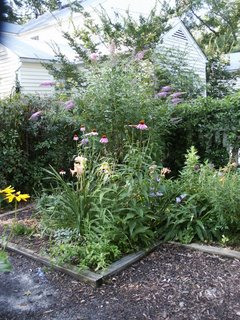
Henry Shaw was an Englishman who moved to St. Louis, Missouri in the early nineteenth century and later became instrumental in establishing the Missouri Botanical Garden.
Shaw never married. His real love was his garden. A story is told that a lady visitor was amazed that he could remember so well the names of the garden’s rare plants. “Madam,” he is said to have replied, “did you ever know a mother who could forget the names of her children? These plants and flowers are my children. How can I forget them?”
Well, sad to say, if my flowers were my children, I’d probably be hauled into family court on the grounds of neglect.
 There are, fortunately, a few late summer bloomers that can take the heat and my periodic negligence. Purple Coneflower (Echinacea purpurea) is one of my favorite summer flowers with dusty pink daisy-like flowers that start blooming in mid-spring and keep right on into the fall. The dried flower heads bequeath hundreds of seeds that can be left to self seed or harvested and started in flats for next year’s bed. Go ahead and get them started now. Don’t wait until spring.
There are, fortunately, a few late summer bloomers that can take the heat and my periodic negligence. Purple Coneflower (Echinacea purpurea) is one of my favorite summer flowers with dusty pink daisy-like flowers that start blooming in mid-spring and keep right on into the fall. The dried flower heads bequeath hundreds of seeds that can be left to self seed or harvested and started in flats for next year’s bed. Go ahead and get them started now. Don’t wait until spring.Shasta Daisies (Chrysanthemum X superbum) inhabit another corner of my side bed and are still going strong now in late August. Shasta daisy is a member of the Asteraceae family and is a hybrid created by Luther Burbank in 1890. The name “Shasta daisy” is said to come from the fact that the clean white petals of the daisy reminded Burbank of the snow on Mount Shasta in California. This cheerful, sun-loving, long-lasting daisy has white petals surrounding a yellow center atop sturdy stems that make it great for cutting. Leucanthemum ‘Becky’ was named the 2003 Perennial Plant of the Year by the Perennial Plant Association. Like the coneflower, it starts blooming in spring and will last into fall. Just give it sun, regular water, and keep it groomed. It will reward you with years of beauty.
 Black-Eyed Susan (Rudbeckia fulgida) is yet another popular, sun-loving perennial that makes a good cut flower. It tolerates poor soil and drought and blooms from summer into fall across a wide range of climates. ‘Goldsturm’ grows about three feet tall and was honored by the Perennial plant Society as the 1999 Perennial Plant of the Year.
Black-Eyed Susan (Rudbeckia fulgida) is yet another popular, sun-loving perennial that makes a good cut flower. It tolerates poor soil and drought and blooms from summer into fall across a wide range of climates. ‘Goldsturm’ grows about three feet tall and was honored by the Perennial plant Society as the 1999 Perennial Plant of the Year.Autumn Joy Sedum must be one of the hardiest plants in my garden and, though we don’t get the bright flowers that appear in cooler climates, there are flowers still, and this sedum is certainly worth growing for its foliage. There are hundreds of plants in the huge and varied sedum genus. Some are low-growing. Others are upright. Most are succulent with thick, fleshy leaves. The best thing about the sedums in my garden, I think is the fact that in the deep, dreary winter when the garden is bare, you happen upon a pot of them and already the new baby plants have begun their spring journey.
Salvia leucantha, or Mexican Bush Sage has tall, deep purple flower spikes that don’t show up until late in the summer. It’s worth the wait, however, and this handsome tender perennial graces gardens from the upstate, where it’s not likely to survive the winter to Charleston, where it probably will. In my salvia madness period in early spring, I bought a pot and left it on the west side of the house where it doesn’t get much water. It’s hanging in however, and will burst forth any day and last until frost. I might have sheared it back a few times during the summer to get lusher blooms.
So, at least my more resilient flower children have nearly made it through another Aiken summer that seems to be getting hotter as we plow into September. Maybe when it cools off I will become a more attentive mother.



